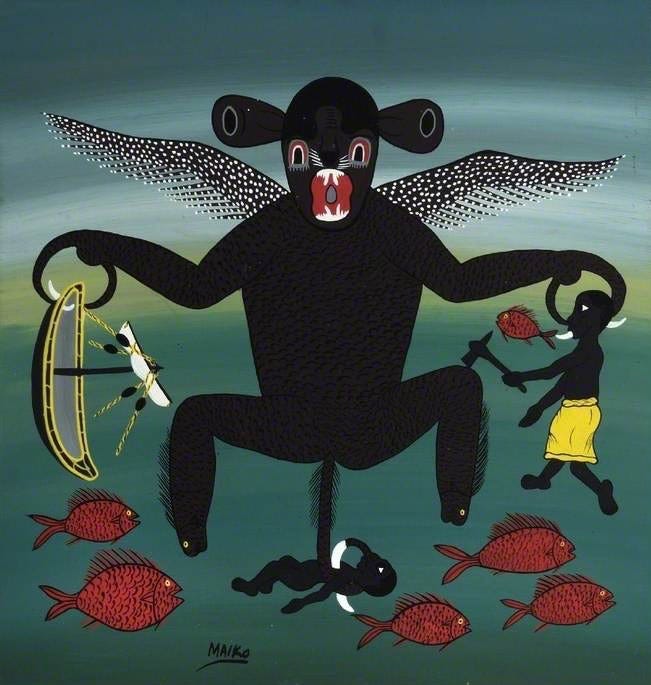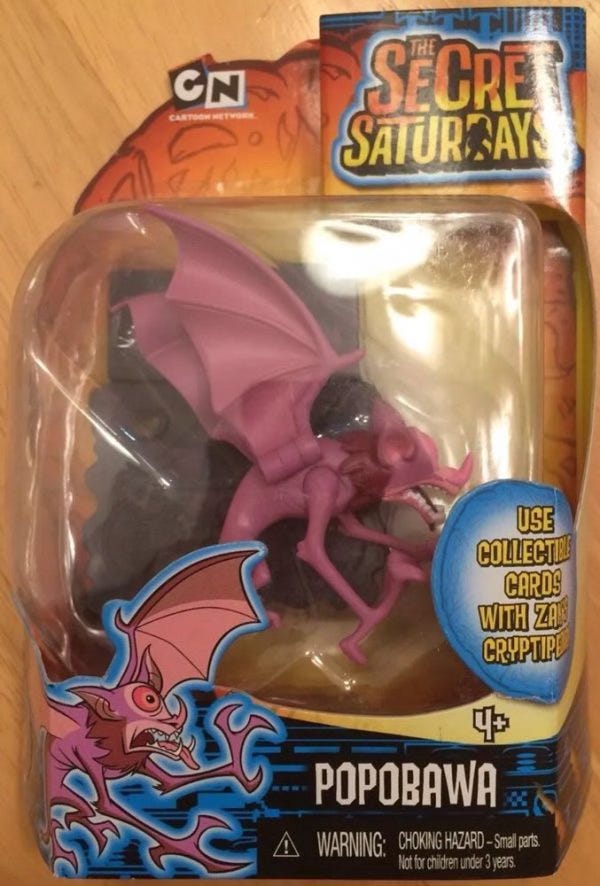Before we get into this week’s monster, a quick note:
If you’ve been thinking of picking up one of my books, now is a great time. I’m running a summer sale! Visit my shop to check it out, and if you make a purchase, shoot me a message. I’ll be sure to include a special subscriber bonus as a thank you.

Popobawa created mass hysteria, panic events in the Tanzania coastal areas and Zanzibar in 1995. I did have some memories of reading about these events when they occurred, but had completely forgot about them until one of the MOW readers,
, reached out to me, mentioning that I should do a Monster of the Week on Popobawa. He is a writer from Tanzania who I’m glad connected with me. Please give him a follow and check out his stories.Popobawa or Popo Bawa (Bat wing)
Origin: Zanzibar, Tanzania
Type: Shapeshifter, incubus, demon, jinn
CATCHPHRASE: Let’s Talk About Sex or Get Out the Vote!
Popobawa is a complicated monster, and he is also relatively new on the world. Mortals only started talking about him in 1965, shortly after the island of Pemba’s political revolution. He is a shetani, a spirit from East African mythology. A shetani is thought to take one of five forms—human, mammal, fish, bird, and reptile. In Popobawa’s case, a bat. He is described as a shapeshifter and incubus, not a pleasant combination for a monster.

One origin story for Popobawa explains that an angry sheikh released a jinn to take vengeance on his neighbor’s but lost control of the entity. The jinn embraced the demonic ways and became Popobawa. The name means “bat wing” in Swahili, and his physical appearance is bat-like. He is also well-endowed which is signifigant to the lore. He is known for sneaking into homesteads at night to physical assault the occupants in their beds which can include sexual assault, often taboo acts, the most feared being anal rape. He attacks both men and women, but prefers men. Popobawa carries amulets and charms, not unlike a sorcerer or uchawi. Some of those charms would account for his terrible sulphuric smell. He is the embodiment of witchcraft.
The similarities to a vampire cannot be ignored, especially with his bat-like appearance and sexual attacks. Some have called Popobawa, The Vampire of Tanzania, although, he does not consume blood or transform his victims so that title does not feel super accurate, more sensational.
Popobawa is not the only incubus that exists in the world’s folklores and mythologies. These creatures pop up everywhere. One of the earliest references to an incubus-like creature is from Mesopotamia (2400 B.C.) where the hero Gilgamesh’s father is listed as Lilu, a male demon who seduces and bothers women in their sleep. The word incubus derives from a Latin word that means “to lie atop”, indicating that the demon lies on top of its victim. The belief in these creatures has at times been attributed to the victim’s experiencing episodes of sleep paralysis and hypnagogia, together they can cause auditory and physical hallucinations, and feel very real and violating. On the more evil and human side of this, some of these incubus encounters could be actual assaults perpetrated by a human while the victim is sleeping or drugged. And equally dark, people have labeled innocent men Popobawa to cause that person physical harm or shame.

Two specific things that set Popobawa apart from other incubus creatures are:
1.) Mass hysteria events created by Popobawa’s supposed assaults.
2.) Popobawa’s insistence that his victims tell others about the assault, or he will return to assault them again.
“In early February 1995, during the first week of Ramadhan, people in the south-west of Pemba Island began to complain of nocturnal assaults by a shape-shifting spirit (Swahili sheitani). They dubbed this spirit ‗Popobawa‘ (literally ‗bat-wing‘), after a similar set of occurrences sometime after the Zanzibar Revolution, during the rule of President Abeid Amani Karume (1964-72). Whereas the original Pemban Popobawa was described as an anal rapist, the new one was said to attack men, women and children in a variety of ways, sometimes by squeezing the ribcages of victims until they lost consciousness. Whatever their particular experiences, all of the victims felt extreme terror, and in many cases were unable to move or speak when they were assaulted.”
In 1995 in Zanzibar, word of these assaults created a mass hysteria event, leading to mobs attacking, and sometimes killing, people they believed to be Popobawa. On the night of May 3rd, 1995, a visitor from the Tanzanian mainland was killed by a frenzied mob who believed he was a manifestation of the shapeshifter. At this point, this spirit had been terrorizing the people of Pemba Island for more than a month. In an account of the events, Killing Popobawa: A Collective Panic and Violence in Zanzibar, Martin Walsh documents the timeline of the panic and describes several of the attacks on men believed to be Popobawa’s, three that lead to death. Two of the attacks occurred on Pemba and the other four were on Unguja. The killing of Mti Pepo followed multiple sightings of the man who had a terrible stench and wore a strange charm. Members of the community chased him down and beat him to death. In reality, he was a mentally ill man that had been brought to the area to be committed to a psychiatric hospital. Henrica Janson (Henriette Jansen) who worked at the Ministry of Health in Zanzibar arrived to work the following day where hundreds had gathered to see the body of the Popobawa. Soldiers had to keep the crowd from entering the mortuary as some attempted to make sure the demon was dead or to get revenge for the assaults on their loved ones. Despite the death of this man, the hysteria continued, many ultimately deciding, he was not the real Popo Bawa.
Some claimed that the authoritarian CCM (Chama Cha Mapinduzi) party sent the Popobawa or used the fear of it to distract the CUF (Civic United Front) supporters in these island regions from campaigning against them in the country’s first national multiparty election. The CCM has remained in control of Tanzania since its inception. The CUF supporters wanted to wage war on the CCM, so on the inverse, maybe this mob violence and anger was really directed toward the CCM. Since, those leaders were too powerful for the violence to really reach them, a few outsiders faced the mob’s wrath and were murdered in this fear-fueled frenzy instead. After all the hysteria and the election, the CCM remained in control of the state.
These types of events can be a reflection of a community’s past trauma and fear combined with its intense anxiety around the future. It is possible that the people of these regions were set-off by the upcoming elections, a chance to transform the nation, and then fueled by residual trauma around the past violence inflicted by their leaders involving the slave trade. This trauma and fear are then triggered by the ruling class, and a folklore devil is born. Regardless of exactly how Popobawa arrived, this type of witch-hunting is not specific to this area. It happened in Salem when the extreme violence in the region’s recent past supercharged the community’s anxiety around its political uncertainty. Combine that energy with puritanical belief systems and superstitious practices, and the fires ignite very easily.
One of the strangest details about the Popobawa is that he insists that the victims are supposed to tell others about the assault, or they will suffer more attacks. This insistence of telling others is in itself very telling. Why does this demonic being want people to talk about the assaults?
This could tie into the theory that political leaders were trying to use this demon to scare the opposition, terrorize them so they couldn’t organize and campaign by sending in a violent boogeyman and then spreading the word to create a frenzied, hysterical mob. This theory that Popobawa was a type of created propaganda seems a bit far-fetched, but not impossible. However, once that fear existed, it seems very plausible different entities might try to use it to their advantage.
I do find a completely different theory much more compelling. It involves Dr. K.D. Thompson’s analysis and book on the Popobawa that explores how Swahili-speakers make use of this legend in their everyday lives and communication, separate from the mass hysteria events. She approaches the monster from a linguist’s perspective. She argues that this demon becomes an appropriate way to discuss sexual transgressions since most of the conversation takes place in culturally sanctioned form like utani (ritualized form of humor) and stories about spirts and spirit possession. Maybe this incubus creates a space where discussing sex, specifically the taboo is allowed and safe.
“My work suggests that talk about Popobawa and other spirits who have sex with humans are not only important means for accessing the voices of Swahili women and queer men but also important means that they use to communicate about their own sexuality. Essentialist Islam is on the rise in Tanzania, leading to even more silencing of women and queer men’s voices. Existing research has obscured the role that Islam plays in the lives of women and queer men as they negotiate their relationships to their religion in ways both orthodox and not. Examining Tanzanian discourses about sexuality and gender through this contemporary trickster tale will make an important contribution to these overlooked aspects of Swahili culture and to our understanding of Muslim gender roles.”
It then becomes possible that this demonic entity from folklore was summoned by humans to allow marginalized people such as women and homosexual men a space to discuss taboo topics and engage in criticism about sexual normativity, male hegemony, and political leadership. It seems this creature could exist both to reveal something darker about humanity and to help humans discuss things that have been forced into the dark.
This monster isn’t used as a warning to keep children out of the woods or away from the water. This monster comes for its victims in their bedrooms when they are sleeping. This monster wants us to talk about that assault, spread word. Whether the Popobawa is a vivid hallucination caused by a well-documented physical event like sleep paralysis, a story spread so people can talk about sex when it is not safe to do so, or a folklore weaponized against a political opponent, it is clear that this monster is not an easy one to categorize. The one lesson that this monster teaches is that it is important to talk things out before those things become our personal and collective demons and tear us apart.
For a lighter story about the Popobawa appearing in a kids cartoon and becoming a Mattel toy, click here.







The fact that Popobawa became a cartoon and a kid's toy is perhaps the scariest thing about it.
Thank you for sharing. I saved it and will read it soon.